Batley
and
Heckmondwike,
Yorkshire
P.E. Brown & Son, 73
Soothill Road
'P.E. BROWN
& SON
Plumbing Contractor'
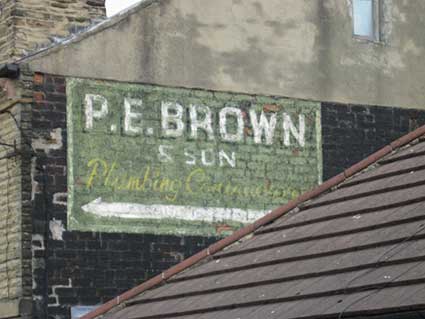
An eye-catcher sign as one travels down the Soothill Road hill
towards Batley Bottoms. White capitals with a black drop-shadow on a
green ground in a white frame. The large lower white arrow presumably
indicated the firm's office, now housing. The bungalow
built beside the houses and in front of this side wall does not obscure
the sign.
Bottoms Mills, 286 Bradford Road
'1875
BOTTOMS MILLS.'
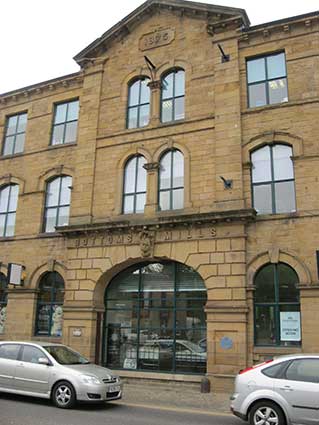
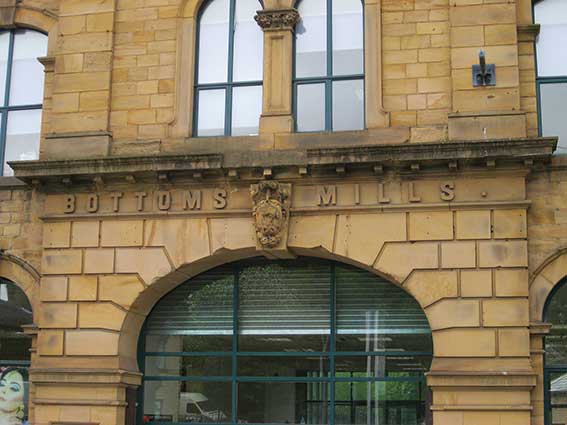
The facade features the date in a cartouche high up. Between the
first and second storey windows, the stonework bears ghost lettering
which might have been incised and later filled in: 'S.J.
STUDLEY' (very speculative). The groundfloor
compressed arch window, with its decorative keystone has suffered
drilling to mount commercial signs several times and the edge of the
stonework is damaged in several places. This was almost
certainly a cart entrance to the mills, so some damage may have
resulted from that traffic.
Around 1850 George and James Stubley set up a business of their
own in a part of Batley known as The Bottoms. Initially they operated
as comission spinners, said to have been working largely for the
Sheards. This prospered and they started making cloth themselves, and
did extremely well during the Crimean War. However, the war's end
brought the cancellation of a large contract for army blankets, and the
firm's survival was endangered. They were, however, able to persuade
their creditors to stand by them.
The firm underwent other vicissitudes, with a major fire in 1860. In
1863 a gale took off the roof of a mill described as new, and
workpeople were fortunate not to be injured. A further fire occurred in
February 1866, damaging a building described as some 12 months old, and
workpeople were fortunate that a prompt alarm allowed them to escape.
Stubleys then rented some space in the Prospect Mill at Birstall, only
to have that burn down in December of that year! Despite this, the firm
continued to expand, and in 1875 the brothers took on extensive mills
at Wakefield. Eventually those creditors who had
stood by them in earlier days were
paid out in full, and a dinner was held at the Batley Station Hotel to
celebrate this. When in
1907 the firm of Messrs Michael Sheard and Son had to close, it was
Stubleys, once their commission spinners, who bought their Hick Lane
Mill. (Information from Vivien Tomlinson's
Family History.)
Clegstyle, 444-446 Bradford
Road
(between Bridge Street and Caledonia Road)
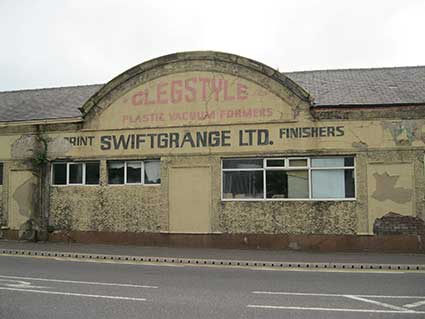
The Geograph
website tells us: 'Swiftgrange Ltd. Print Finishers,
Bradford Road, Batley. The name of a former occupier - Clegstyle
Plastic Vacuum Formers - can still be seen above that of the present
(or most recent) use. The elegant curved panel in the centre of the
building suggests perhaps an art-deco influence, dating it to the early
20th century, but even larger scale old maps don't give any clue to
when it was built or its original use. Behind it was the Victoria Iron
Foundry.'
Park Road School, Park Road
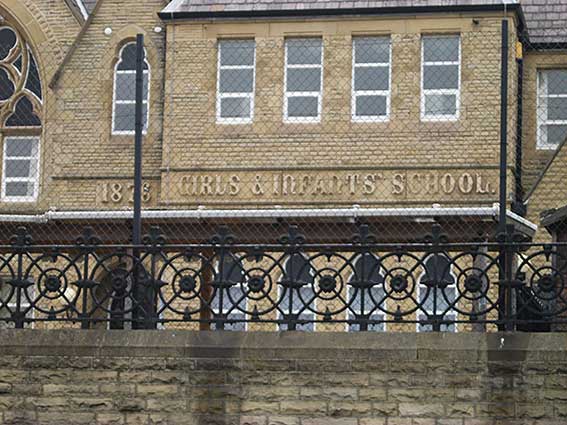
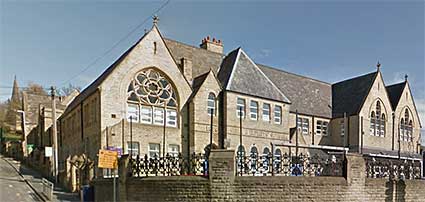
Above: The view from Bradford Road.
'1876 ... GIRLS & INFANTS' SCHOOL'
This almost florid lettering
features an admirable use of the plural possessive apostrophe.
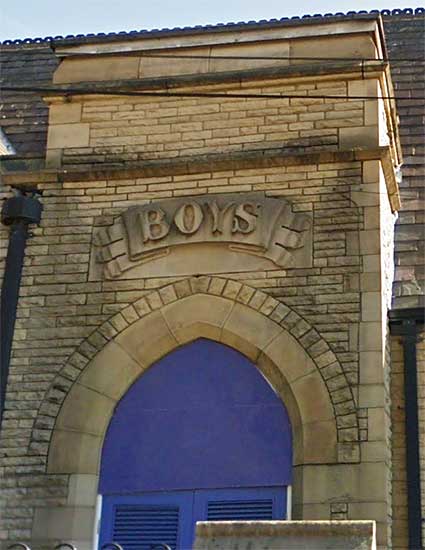
The entrance up the hill of Park Road features the 'BOYS'
lettering in the same style on a tripled scroll in the local stone.
Partially filled in, this entrance is now a storage area with louvres
in the doors.
Freemasons Hall, Park Road
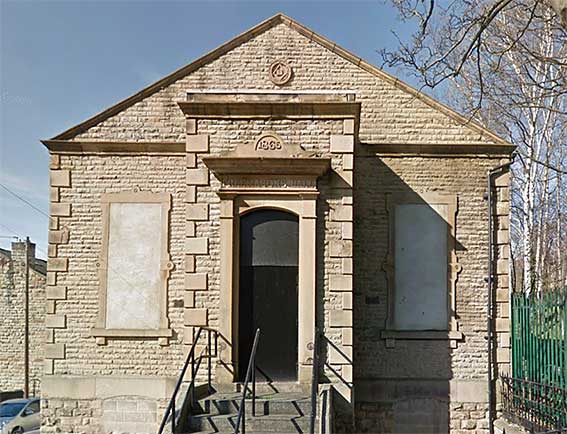
Almost opposite the boys' entrance to the school stands this
lettered
hall.
'1865
FREEMASONS HALL'

Howley Lodge started off at the Freemasons Hall, Park Road in
1928 and moved to Blenheim House, Batley in January 1935. The name
Howley is taken from Howley Hall which was a predominate feature of
this
area in the 17th Century. Clearly it was used by others between 1865
and 1928. The circular feature contains typical masonic
symbols: dividers and set-square with a book(?) in the centre, the
whole surrounded by a circle of foliage.
Taylor's Blakeridge Mills,
Blakeridge Lane
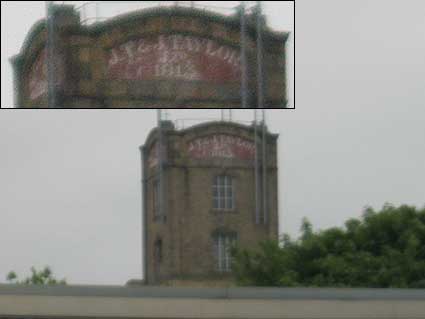
This distant view of the top of the mill from Bradford Road
shows that the top remains lettered on all faces:
'J.[,]T. & J.
TAYLOR LTD
1913'
Thomas Taylor, born 28th
November 1778, seems to have founded the firm in the 1820s. He had a
house at Crossbank, Batley with a small 3 storied mill in front and a
weaving shed behind and a 2 storied press shop nearby, on the site
which was to develop into Blakeridge Mills, but at the time was known
locally as 'Tommy Taylor's Mills'. Thomas's use of the local beck in
his business led to its pollution and a falling out with the local
vicar, through whose garden it ran. The Taylors stopped attending the
Church of England. Thomas was recorded as being a woollen manufacturer
on the 1841 Census, but by 1851 still only employed 5 men and 2 boys.
It was his sons who really developed the business from around 1845
onwards. He and his wife, Rebecca, had seven sons, three of whom
continued to run the business in partnership in newly steam-powered
mills. These were John, born in 1817, Thomas born 1819 and Joshua born
1821 and the company became J., T. and J. Taylor. In 1851 the
three of them employed 21 men, 15 women and 13 children, but this was
only the beginning. The Blakeridge works were extended, new units being
added and others enlarged, eventually after even more additions,
becoming known as 'Blakeridge Mill Village'.
In 1879, the year Joshua died, Theodore took over his father's role and
became part designer, salesman, buyer and blender. His younger brother,
Arthur, and cousins John Taylor and later Thomas Frederick Taylor
joined him in running the company, the latter in 1883, but by January
1892 all had agreed to let Theodore take complete control. By now the
company was operating from 3 big mills: Blakeridge,
Cheapside and Branch Road, Batley and they also came to own Waterloo
Mills at Bramley, Leeds. It took advantage of the new ready-to-wear
clothing business which had originated in Leeds, providing all the
desirable and necessary fabrics. Theodore had entered politics in 1889
being elected to the new West
Riding County Council, but in 1900 was persuaded to stand for
parliament, becoming a Liberal M.P. J.,T. &
J. Taylor Ltd, were the largest woollen manufacturers in
Batley. Most processes were carried out at the mills, from
raw wool to finished cloth and, particularly in its early days, the
firm was involved in rag-grinding.
(Information
from Kirklees
Curiosities.)
Tramway Company, Bradford Road
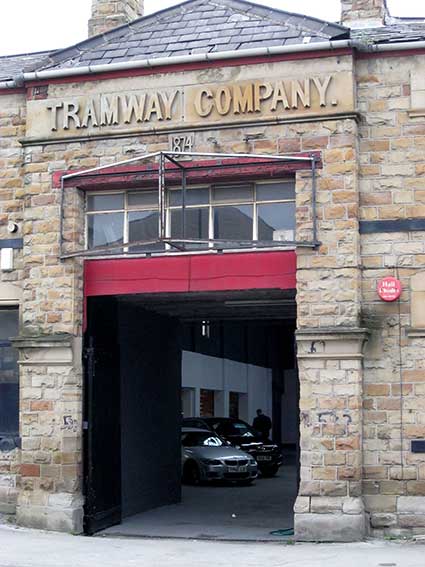

'TRAMWAY COMPANY.
1874'
The lettering here has been
decorated by the removal of a triangle from each ascending and
descending arm of the capitals; there is a flare on the centre of each
curve, except for the 'R'. The entrance would
originally have been opened to the lintel just below the carved date to
accommodate tramcars running on their rails off the road way and across
the pavement.
The Dewsbury, Batley and Birstall Tramway Company was sold to the
British Electric Traction Company on 30th June 1901 and was operated by
electricity from July 1903. (Information from Kirklees
Curiosities.)
National School, Bradford Road
'1848
NATIONAL SCHOOL'
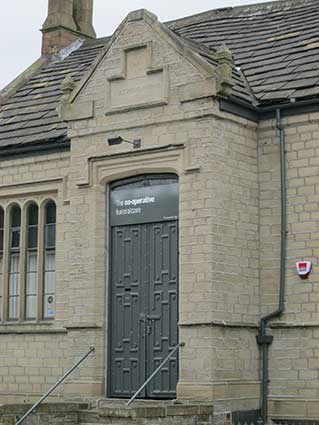
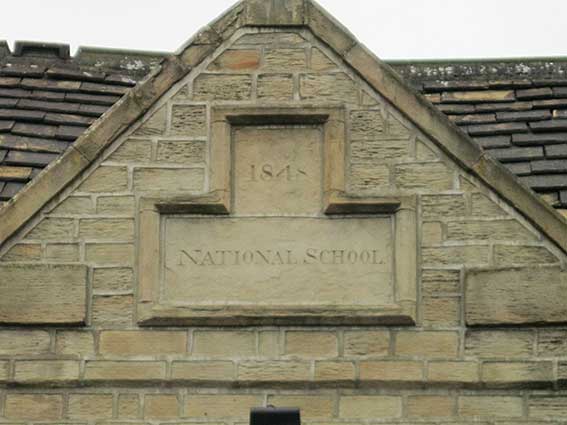
The debtors' courthouse, now on Bradford Road, was built in
countryside around 1780. Although close to tracks between
Batley and Birstall and off to Morley, the road itself was not built
until 1832. Parliament had approved the idea of speeding up the hearing
of small debt cases (under 40 shillings) by providing these small local
courthouses. Previously debtors might be thrown in jail, sometimes with
their families, and have to wait months, at their own expense, for a
hearing at a court some distance from home, in this case at Wakefield
or Pontefract. These small courts were presided over by commissioners
rather than a judge, and 12 local men were appointed for Batley. To be
eligible, a man had to own property fetching £60 a year in rent and
hold £1,500 in assets.
They were assisted by a clerk of court who registered complaints and a
Beadle who found the debtor and served him with a summons. The
Beadle might also organise an auction of the debtor's belongings to pay
off his debt, where deemed necessary, and he kept order in court.
He had the power to have anyone threatening or abusing a commissioner
arrested. At Batley his office was in the basement of the
building. If the case was proved, debtors were made to pay up, perhaps
in installments, or sent to jail for up to 60 days, although the
commissioners could show leniency where the debtor was thought to be
'honest but unfortunate'. Such men were allowed to keep
the tools of their trade and work to gradually pay off their debts.
These new courts didn't hear cases involving debts due to drinking or
gambling or matrimonial disputes, however. Batley's small
courthouse continued to operate until 1846 when its role devolved to
the new County Court in Dewsbury.
After this, in 1848, the building became a National School with
the aim of providing its pupils with an elementary education whilst
instilling Church of England values. After the terror of the French
Revolution, fear of social revolution gripped the country.
National Schools attempted to counteract any revolutionary ideas
circulating amongst the young. The school at Batley had only one
classroom and the teacher had his living quarters in the basement. His
salary may have depended on how well his pupils performed when the
inspectors called annually, so he was usually a hard taskmaster, and
caning was not uncommon. The National School continued until 1870 when
the Education Act ensured many more schools were established to
provide free education for the majority of children.
After this, the building was used as a Sunday School until 1907, then
as an Institute in which young people could meet and play games. It
then stood empty for years until bought as a workshop by a local joiner
and undertaker. It is presently operates as a Chapel of Rest.
(Information from Kirklees
Curiosities.)
The Union Rooms, Hick Lane
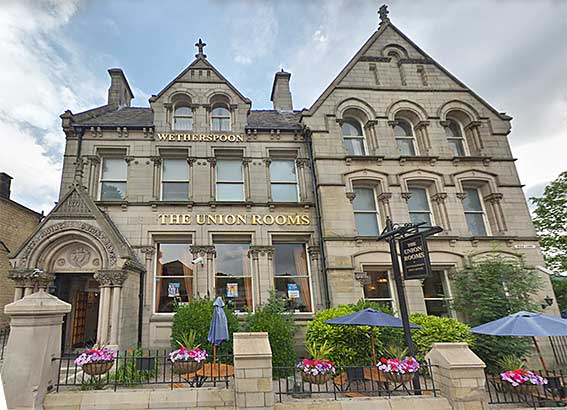
The West Riding Union Bank evolved out of private banks
operating in Huddersfield, Mirfield and Dewsbury. The Mirfield bank was
established in 1799 by Benjamin Wilson. He extended the business into
Huddersfield and took his sons into partnership as Benjamin Wilson and
Sons. Benjamin Wilson served on the provisional committee for the
establishment of a joint stock company to continue the business of the
private partnership. Thus, the Mirfield and Huddersfield District
Banking Co was established by deed of settlement in December 1832, with
the Wilsons being principal shareholders. It was decided to alter the
name to the West Riding Union Banking Co. after the acquisition of
Hagues, Cook and Co. of Dewsbury in 1836. After the amalgamation, the
board met alternately at Huddersfield and Dewsbury. In 1874, the Bank
was incorporated under the Companies Act. By 1876 the West Riding Union
Bank has been trading well, building up good reserves and surplus funds
sufficient to be able to build a number of new branches, and a brand
new office of the West Riding Union Bank was opened in 1877 at Hick
Lane, Batley. This grand, ecclesiastical-looking
building was erected some
twenty-six years before the absorption of the West Riding Union Bank by
the Lancashire and Yorkshire Bank.
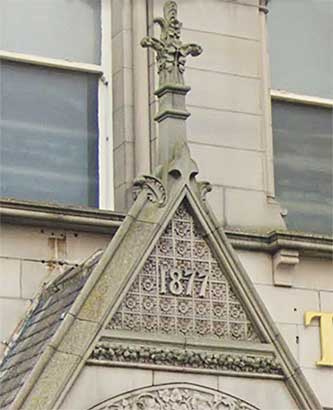
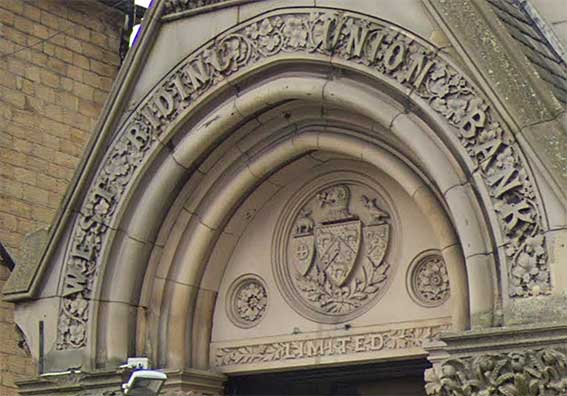
'1877
WEST RIDING UNION BANK
LIMITED'
The ornately-carved porch
features decorative capitals ranged on an arch of grape vines, with the
smaller 'Limited' sitting on different foliage. It is
Listed Grade II:
'Detached bank building in Free Gothic style. Dated 1877. Ashlar.
Steeply pitched gabled slate roof with ashlar roll top copings. Good
ashlar stacks with caps. 2 carved finials. Paired moulded brackets to
gutter. 3 storeys. 7 bay entrance front, the 3 bays to right breaking
forward slightly with gabled roof. Windows to right are archivolted and
have engaged colonnettes with richly foliated capitals. Windows to
ground floor are square headed, those to lst floor have shallow
segmental head, and those to 2nd floor have stilted round arch with
pointed hood mould. In gable apex is blind round arched window, flanked
by blind recesses, with archivolt of richly carved foliage. To left,
windows are square headed with detailing as before. In small gable are
2 round headed windows. Stone entrance porch to left is elaborately
carved with 3 engaged columns to each side with capitals of richly
carved foliage. Round arch over doorway has inscription WEST RIDING
UNION BANK LIMITED. In gable apex of porch is carved diaper work with
date 1877. In tympanum is round carved plate with 3 shields, the centre
one bearing the Huddersfield coat of arms. The interior has been
altered. Ashlar boundary walls with iron railings which return to
building. 5 square, ashlar gate piers with tapering chamfers leading to
octagonal pointed cap.'
Since closure, it has been converted into a pub-restaurant.
Methodist Church, Hick lane
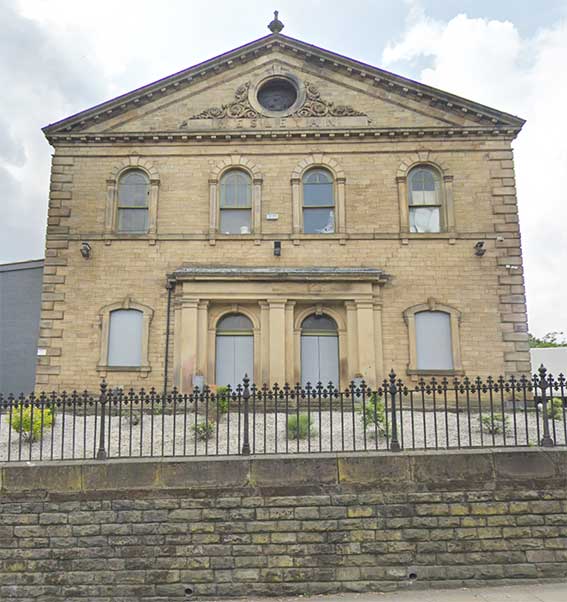

The word 'Weslyan' in capitals is easy to miss. This building is
Listed Grade II:
'Methodist Chapel. Circa 1870. Dressed stone with ashlar dressings and
rusticated ashlar quoins. Pitched slate roof. 6 bay hall with 4 bay
pedimented gable front. 2 storeys. 1st floor sill band.
Paired entrances with plain pilaster surround and common entablature.
Single sash to each side with segmental head with deep key, and
marginal glazing. 4 round arched sashes to 1st floor with plain
pilaster surrounds, rusticated voussoirs and marginal glazing. Pediment
has oculus with scrolled surround, and word WESLEYAN below. Vase
acroterion. Windows to right elevation are detailed as before, though
one is enlarged to form recent doorway. Left elevation is obscured by
recent brick infill.'
It has been used by businesses in recent years.
Freemasons Hall, Park Road

'1865
FREEMASONS HALL'

Howley Lodge started off at the Freemasons Hall, Park Road in
1928 and moved to Blenheim House, Batley in January 1935. The name
Howley is taken from Howley Hall which was predominate feature of this
area in the 17th Century. Clearly it was used by others since its
opening and up to 1928. The circular feature contains typical masonic
symbols: dividers and set-square with a book(?) in the centre, the
whole surrounded by a circle of foliage.

Hick Well Mills was John Burnley's mill. It was he who is said
to have set up a rag machine in his barn in around 1813, worked by
donkey power, and in competition with Benjamin Law's early experiments
to produce shoddy*. By the time Hick Lane Mill was built the new
product was clearly viable, and he was one of those originally involved
there. Some time later John set up on his own at Hick Well nearby. This
venture seems to have prospered in his time, and the firm is said to
have been making druggets and pilot cloths, described as Batley's
special line. (Information from Vivien Tomlinson's
Family History.) One wonders if the well, after
which the original mill was named was owned by the Hick family (and so
the lane was named)?
[*Shoddy is a well-known term in this area. Batley had its own
speciality: the invention of the process for recycling rags to make new
cloth is attributed to Benjamin Law of Batley. Batley and the other
shoddy-producing towns of Morley, Dewsbury and Ossett were looked down
on by Leeds and Bradford, producers of fine woollens and worsteds. Yet
shoddy was the solution to shortages of yarn for weaving due to trade
embargoes during the Napoleonic Wars. And was later used for military
uniforms and blankets, along with many other types of cloth – and even
manure. Fortunes were made from the production of shoddy, including
that of George Sheard – see under the Tramway Company entry.]
Heckmondwike
Plumber sign on
Westgate/Greenside
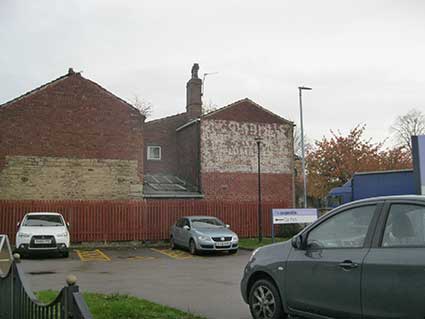
Gledhill plumbers
This sign has been overwritten but the original text refers to H. L.
Gledhill and his skills as a plumber. Henry Leadbeater Gledhill was
born in the town in 1852, the eldest son of Tom Gledhill and his wife
Sarah. Tom was a surveyor and inspector, a respectable job, and the
family must have been reasonably well off. At age 8 though, for some
reason, Henry was living with his grandfather, Joseph, and great
grandmother, Sarah, in High Street, Heckmondwike, but by 1871 was back
home with his parents and siblings, and, aged 18, was already
working as a plumber and eventually had his own business in the town.
In October 1873 Henry was called as a witness in a court case, recorded
in the Huddersfield Daily Chronicle, in which a local man was accused
of being drunk and disorderly and assaulting a police officer.Then late
in 1874 he married Jane Ann Metcalfe and the couple found a home of
their own in Green Side, Heckmondwike.
Things were not going too well for the business, however, which went
into liquidation in 1876, Henry being declared bankrupt in 1878.
Apparently undaunted, Henry and Jane Ann simply upped sticks and by
1881 had moved to the Scarborough area on the north Yorkshire coast
where Henry continued to ply his trade as a plumber. Somehow the
Heckmondwike business bearing his name continued, though, even
advertising in the Huddersfield
Daily Chronicle for 'a good plumber with tools' to work for them
in October 1877 with the offer of regular employment. In 1901
Henry and Jane are recorded as residing in Town Street, Filey. The
couple don't appear to have had any children and Henry in fact died
there in early 1904 aged only 52. (Information from Kirklees
Curiosities.)
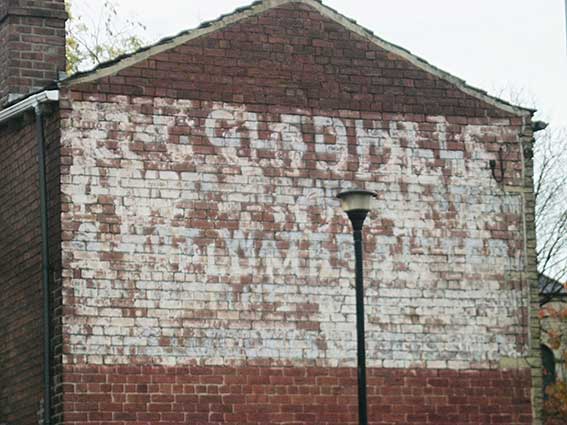
'GLEDHILL' is clearly visible at the top, with 'PLUMBERS'
below.
The words '... WATER FITTER' are overpainted lower down.
It looks as if the whole panel has been over-painted with
whitewash (now weathering away).
Pavement cover, Westgate
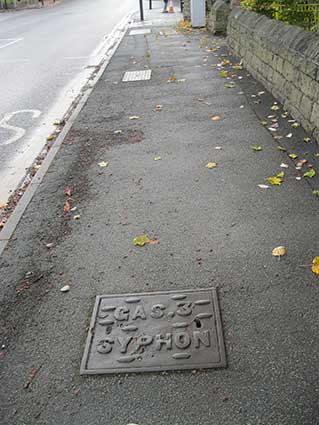
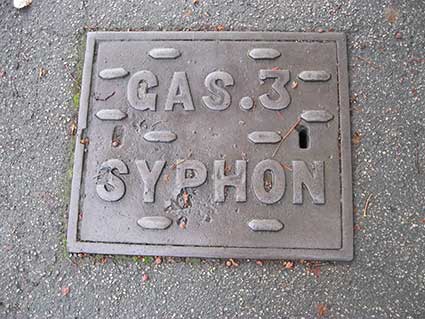
This chunky cast iron cover sits in the middle of the pavement
by Algernon Firth* Park and play area on the edge of Heckmondwike.
Perhaps larger than expected and with large capitals (with slightly
wonky 'S's) , it includes non-slip lozenges. One assumes that the
utilty cover relates to the public gas supply, although we haven't been
able to find a similar example.
[* Sir Algernon Firth was a man ahead of his time, whose
philanthropy provided hope to cancer sufferers around the world. When
he died in 1936, he left behind a laboratory (now Listed Grade II, but
used as student accommodation) which provided inspiration for the
finest medical minds.']
Home
Return
to Historic Lettering from outside
Ipswich
Please email any comments and contributions by clicking here
Search Ipswich
Historic Lettering
©2004 Copyright
throughout the Ipswich
Historic Lettering website: Borin Van Loon
No reproduction of text or images without express
written permission

























